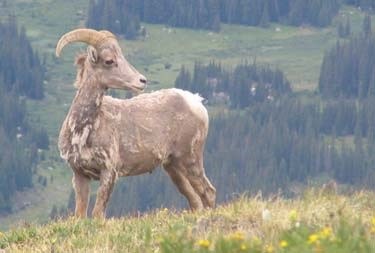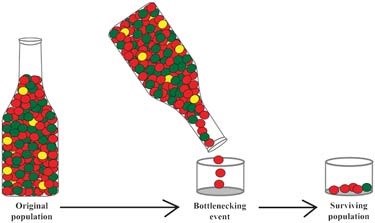Last updated: November 8, 2022
Article
Population Genetics of Bighorn Sheep

The Question: Is the Mummy Range bighorn sheep population subject to negative effects from inbreeding after a recent pneumonia-induced population die-off?
Bighorn sheep (Ovis canadensis canadensis) of the park’s Mummy Range suff ered a population size reduction associated with a pneumonia die-off in the 1990s. Some managers wondered if the event was enough to induce a “population bottleneck,” an evolutionary event that reduces genetic variation and results in increased inbreeding due to the reduced pool of possible mates. The smaller gene pool can subsequently reduce fi tness (e.g., lamb survival, reproduction) and the ability to adapt to future environmental changes (e.g., disease, environmental stress). If a severe bottleneck was detected in the Mummy Range band, management actions could be undertaken to supplement the population numbers as a way to improve genetic fitness and bolster the probability of the band’s survival.
The Project: Collect bighorn sheep pellets and test for genetic variation and parasite load.
In 2005 Researcher Gordon Luikart of the University of Montana and park volunteers collected fecal pellets near the Sheep Lakes mineral lick area and in the Mummy Range. Great care at the sampling locations minimized wildlife disturbance. In the lab Luikart extracted DNA, the material inside the nucleus of cells that carries genetic information, from the fecal pellets and analyzed it for genetic variation. Scientists used statistical approaches to test for population bottlenecks and to determine if the herd has received recent immigrant individuals that might increase genetic variation. Parasite analysis in feces determined the presence of lungworm larvae, of which a high load may predispose bighorn to pneumonia outbreaks.
The Results: The Mummy herd has not suffered a severe reduction of genetic variation, yet the data suggest that reduced variation at genes associated with immune system function can lead to reduced parasite resistance.
The test for distribution of genes in the Mummy Range band of bighorn sheep yielded results consistent with a non-bottlenecked population. However tests did not identify any genotypes from outside the population, providing evidence that no recent immigrants exist in the Mummy band, thus reducing the gene pool. Scientists detected lungworm larvae (which likely contribute to pneumonia die-offs) in more than half the fecal samples. Heterozygosity, which is the presence of two different alleles or minor variations of the same gene at a given position on a chromosome, apparently benefits the herd. Individuals with more heterozygosity (variation) had fewer parasites. Though the sample size was small, this data suggests that reduced genetic variation (inbreeding) can lead to reduced parasite resistance.
Through this noninvasive type of project investigators can study some aspects of wildlife populations that previously involved intensive capture operations. For instance in the future the park may be able to track populations through sampling of fecal pellets rather than through collaring.
This summary is based on published, peer-reviewed and/or unpublished reports available at the time of writing. It is not intended as a statement of park policy or as a definitive account of research results. For more information on the park’s research program, see www.nps.gov/romo
Written by: Colleen Flanagan Date: September 2005 Updated: May 2009 Photo credit: NPS-RMNP and Pearson Education, Inc. published as Benjamin Cummings
